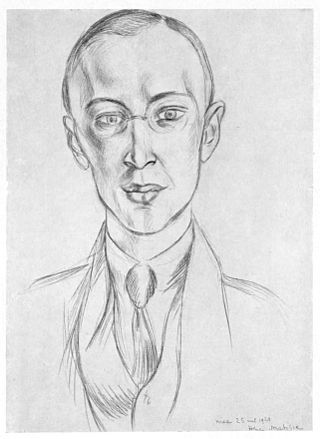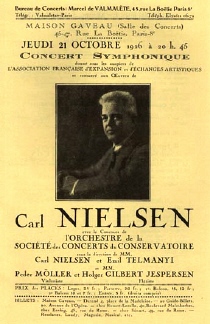Related Research Articles
A concerto is, from the late Baroque era, mostly understood as an instrumental composition, written for one or more soloists accompanied by an orchestra or other ensemble. The typical three-movement structure, a slow movement preceded and followed by fast movements, became a standard from the early 18th century.

The Violin Concerto in D major, Op. 35 was the only concerto for violin composed by Pyotr Ilyich Tchaikovsky. Composed in 1878, it is one of the best-known violin concertos.

Serge Koussevitzky was a Russian and American conductor, composer, and double-bassist, known for his long tenure as music director of the Boston Symphony Orchestra from 1924 to 1949.

Sergei Rachmaninoff's Piano Concerto No. 3 in D minor, Op. 30, was composed in the summer of 1909. The piece was premiered on November 28 of that year in New York City with the composer as soloist, accompanied by the New York Symphony Society under Walter Damrosch. The work has the reputation of being one of the most technically challenging piano concertos in the standard classical piano repertoire.

Sergei Prokofiev wrote his Symphony No. 2 in D minor, Op. 40, in Paris in 1924-25, during what he called "nine months of frenzied toil". He characterized this symphony as a work of "iron and steel".

Sergei Prokofiev wrote his Symphony No. 3 in C minor, Op. 44, in 1928.

Felix Mendelssohn's Violin Concerto in E minor, Op. 64, MWV O 14, is his last concerto. Well received at its premiere, it has remained among the most prominent and highly-regarded violin concertos. It holds a central place in the violin repertoire and has developed a reputation as an essential concerto for all aspiring concert violinists to master, and usually one of the first Romantic era concertos they learn. A typical performance lasts just under half an hour.
Piano Concerto No. 3 in C major, Op. 26, is a piano concerto by Sergei Prokofiev. It was completed in 1921 using sketches first started in 1913.
Sergei Prokofiev set to work on his Piano Concerto No. 2 in G minor, Op. 16, in 1912 and completed it the next year. However, that version of the concerto is lost; the score was destroyed in a fire following the Russian Revolution. Prokofiev reconstructed the work in 1923, two years after finishing his Piano Concerto No. 3, and declared it to be "so completely rewritten that it might almost be considered [Piano Concerto] No. 4." Indeed, its orchestration has features that clearly postdate the 1921 concerto. Performing as soloist, Prokofiev premiered this "No. 2" in Paris on 8 May 1924 with Serge Koussevitzky conducting. It is dedicated to the memory of Maximilian Schmidthof, a friend of Prokofiev's at the Saint Petersburg Conservatory, who had committed suicide in April 1913 after having written a farewell letter to Prokofiev.

The Violin Concerto No. 2 in G minor, Op. 63, written in 1935 by Sergei Prokofiev, is a work in three movements:
- Allegro moderato
- Andante assai
- Allegro, ben marcato
Sergei Prokofiev's Symphony No. 7 in C-sharp minor, Op. 131, was completed in 1952, the year before his death. It is his last symphony.
Sergei Prokofiev's Piano Concerto No. 4 in B-flat major for the left hand, Op. 53, was commissioned by the one-armed pianist Paul Wittgenstein and completed in 1931.
The last complete piano concerto by Sergei Prokofiev, Piano Concerto No. 5 in G major, Op. 55, dates from 1932.
Aram Khachaturian's Piano Concerto in D-flat major, Op. 38, was composed in 1936. It was his first work to bring him recognition in the West, and it immediately entered the repertoire of many notable pianists.

Paul Kochanski was a Polish violinist, composer and arranger active in the United States.
The Concert Fantasia in G, Op. 56, for piano and orchestra, was written by Pyotr Ilyich Tchaikovsky between June and October 1884. It was premiered in Moscow on 6 March [O.S. 22 February] 1885, with Sergei Taneyev as soloist and Max Erdmannsdörfer conducting. The Concert Fantasia received many performances in the first 20 years of its existence. It then disappeared from the repertoire and lay virtually unperformed for many years, but underwent a revival in the latter part of the 20th century.
Benjamin Britten's Violin Concerto, Op. 15, was written from 1938 to 1939 and dedicated to Henry Boys, his former teacher at the Royal College of Music. Britten worked on it while staying with Aaron Copland and completed it in Quebec. It was premiered in New York on 29 March 1940 by the Spanish violinist Antonio Brosa with the New York Philharmonic conducted by John Barbirolli.

Carl Nielsen's Concerto for Flute and Orchestra was written in 1926 for Holger Gilbert-Jespersen, who succeeded Paul Hagemann as flautist of the Copenhagen Wind Quintet. The concerto, in two movements, was generally well received at its premiere in Paris in October 1926 where Nielsen had introduced a temporary ending. The first complete version was played in Copenhagen the following January. The flute concerto has become part of the international repertoire.
Marcel Darrieux was a French classical violinist, particularly known for premiering Sergei Prokofiev's 1st Violin Concerto in 1923.
The bassoon repertoire consists of pieces of music composed for bassoon as a principal instrument that may be performed with or without other instruments. Below is a non-exhaustive list of major works for the bassoon.
References
- ↑ Steinberg, 349.
- 1 2 3 Steinberg, 350.
- 1 2 Daniel Jaffé, booklet note to CD recording: Sarah Chang, Berliner Philharmoniker cond. Simon Rattle (EMI 3 46053 2)
- ↑ Jaffé (1998): p. 92
- ↑ Prokofiev (1991): p. 275
- ↑ Classical Archives
- ↑ Kurt Weill: A Detailed Chronology
- ↑ Phillips (2008): 712
- ↑ "BSO Program Notes" (PDF). Archived from the original (PDF) on 2010-09-24. Retrieved 2009-03-06.
- ↑ Steinberg, 351.
- ↑ Quoted in Steinberg, 350.
- 1 2 3 Scholz, Horst A. (2016). Sergei Prokofiev: Violin Concertos Nos 1 & 2; Sonata for Solo Violin (PDF) (Media notes). BIS Records. p. 5.
- ↑ Steinberg, Michael (2000). The Concerto: A Listener's Guide . Oxford University Press. p. 351.
- ↑ Steinberg, Michael. "Prokofiev: Concerto No. 1 in D Major for Violin and Orchestra, Opus 19". San Francisco Symphony. Archived from the original on 28 February 2017. Retrieved 1 March 2017.
- ↑ Scholz, Horst A. (2016). Sergei Prokofiev: Violin Concertos Nos 1 & 2; Sonata for Solo Violin (PDF) (Media notes). BIS Records. pp. 5–6.